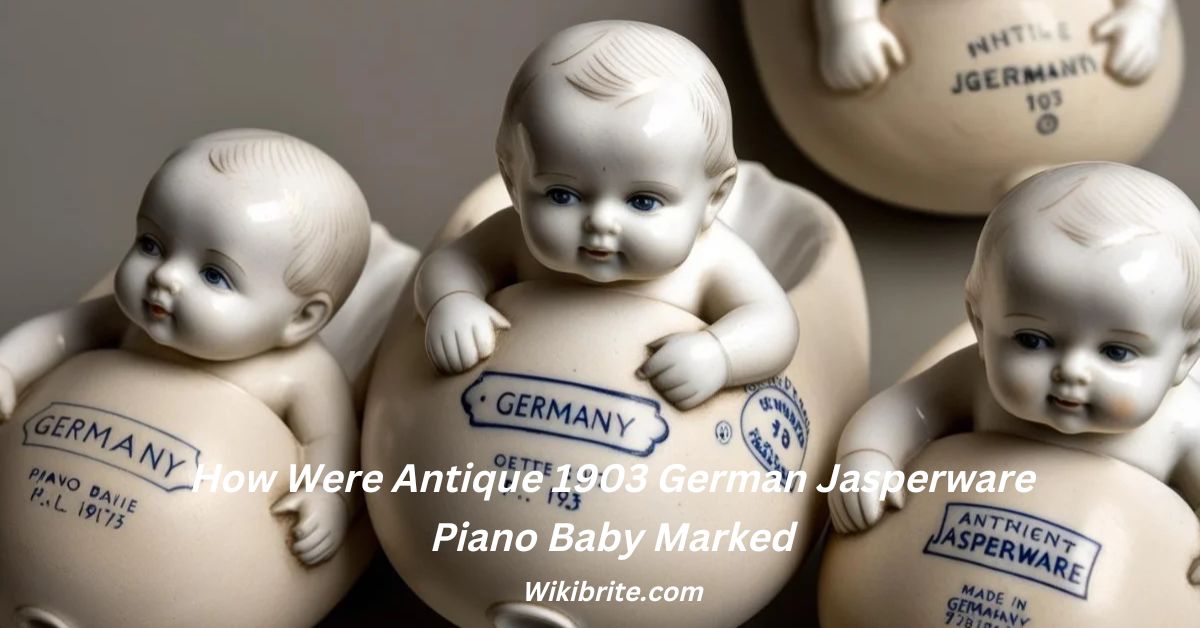If you’re a fan of antique figurines, particularly the charming 1903 German Jasperware Piano Baby, you may be curious about how these porcelain treasures were marked.
Understanding the marking on these figurines not only adds to their appeal but also helps collectors identify and value them.
In this comprehensive guide, we’ll explore how antique 1903 German Jasperware Piano Babies were marked, offering a deep dive into their history, the significance of the markings, and tips for collectors.
Table of Contents
- Introduction to Antique 1903 German Jasperware Piano Babies
- What is Jasperware?
- History of the 1903 German Jasperware Piano Baby
- How Were Antique 1903 German Jasperware Piano Babies Marked?
- Manufacturer’s Marks: What Do They Signify?
- Common Markings on 1903 German Jasperware Piano Babies
- Uncommon or Rare Marks
- Understanding the Marking Styles on Piano Babies
- Stamps and Imprints
- Painted Marks and Logos
- Why Are the Marks Important for Collectors?
- Tips for Identifying Authentic Antique 1903 German Jasperware Piano Babies
- How to Care for Antique Jasperware Figurines
- FAQs about How Were Antique 1903 German Jasperware Piano Baby Marked
- Conclusion
Introduction to Antique 1903 German Jasperware Piano Babies
The 1903 German Jasperware Piano Baby is a fascinating and highly sought-after collectible.
These delicate porcelain figurines, crafted with exquisite detail, depict babies and young children often posed playing musical instruments, particularly the piano.
Jasperware itself is a type of porcelain that is known for its matte finish, smooth texture, and striking colors. These figures were often made in the early 20th century by German porcelain manufacturers.
The specific year 1903 adds an element of rarity and charm to these figurines. If you’ve ever wondered how antique 1903 German Jasperware Piano Babies are marked, you’re not alone.
Many collectors are keen to understand the different marks that appear on these figurines, as they play a significant role in determining authenticity, origin, and value.
What is Jasperware?
Before diving into the markings, it’s important to understand Jasperware as a material. Jasperware is a type of porcelain that originated in England in the 18th century, popularized by Josiah Wedgwood.
It was later adopted by German porcelain manufacturers in the late 19th and early 20th centuries.
The defining characteristic of Jasperware is its unique matte finish, which gives it a soft and smooth appearance. It is often found in various colors such as blue, green, black, and white.
The famous blue color, known as Wedgwood blue, was commonly used for figurines like the 1903 German Jasperware Piano Baby.
History of the 1903 German Jasperware Piano Baby
1903 German Jasperware Piano Babies were made by German porcelain manufacturers, many of whom were known for their craftsmanship during the early 20th century.
These figurines were part of a broader trend of piano babies—small, often highly detailed, porcelain figures of children in various poses.
The “piano baby” term is derived from the figurines’ popularity as decorative pieces placed on top of pianos during the late 19th and early 20th centuries.
The 1903 marks are of particular interest to collectors because this was a period when German porcelain manufacturers were refining their production methods.
The figurines often featured soft colors and delicate designs, with each one meticulously painted and finished.
Also Read: Rader Principal Ruhl School Kansas City_ A Transformational Story of Leadership and Education
How Were Antique 1903 German Jasperware Piano Babies Marked?
Understanding the marks on 1903 German Jasperware Piano Babies is key to identifying the origin and authenticity of the figurine.
Most of these figurines bore a manufacturer’s mark, which often included the company’s name, logo, or initials. Below, we’ll break down the most common marking styles found on these figurines.
1. Manufacturer’s Marks: What Do They Signify?
The marks on 1903 German Jasperware Piano Babies often provided valuable information about the manufacturer, the quality of the porcelain, and the period in which it was made.
In general, these marks were imprinted or painted on the bottom of the figurine and included the following:
1. Company Name:
The full name of the manufacturer.
2. Logo or Initials:
This could be a simple set of initials or a more elaborate logo that identified the factory.
3. Country of Origin:
German porcelain manufacturers were required by law to mark their items with the country of origin, often with the word “Germany.”
2. Common Markings on 1903 German Jasperware Piano Babies
1. KPM (Königliche Porzellan-Manufaktur):
This mark often appears on high-quality pieces and indicates a product made by the renowned Berlin-based manufacturer.
2. Boehm:
Another prestigious German porcelain manufacturer, often associated with finely detailed figurines like the 1903 German Jasperware Piano Babies.
3. Nymphenburg:
A well-known maker of fine porcelain, often marked with a distinctive logo and sometimes paired with a date mark.
These markings were usually in the form of an impressed stamp on the bottom of the figurine.
Some pieces may also have a painted mark in gold or underglaze, depending on the manufacturer.

3. Uncommon or Rare Marks
In some cases, 1903 German Jasperware Piano Babies can feature rare or unusual marks, which can add significant value to a piece. These might include:
1. Art Nouveau or Art Deco Inspired Designs:
These marks often included stylized logos or symbols associated with the artistic movements of the early 20th century.
2. Personalized or Limited Edition Marks:
Occasionally, manufacturers would release limited edition pieces with unique marks, which can be of great interest to collectors.
Understanding the Marking Styles on Piano Babies
The way these marks were applied to the figurines varies, and collectors should be aware of the different marking techniques used on 1903 German Jasperware Piano Babies.
Stamps and Imprints
The most common form of marking on these figurines was an impressed stamp.
This means that the manufacturer’s mark was physically pressed into the bottom of the porcelain while it was still soft.
These marks tend to be subtle but are often well-preserved over time.
Painted Marks and Logos
In some cases, marks were painted onto the figurine, either using gold paint or underglaze.
These painted marks may be less permanent than impressed stamps, but they are still valuable for identifying the piece’s origin.
Also Read: Replacement Indulgence Mutation X V5 RDA Ceramic Insert_ Everything You Need to Know
Why Are the Marks Important for Collectors?
The marks on 1903 German Jasperware Piano Babies are more than just a way to identify the manufacturer. They serve several purposes for collectors:
1. Authenticity:
Verifying the mark ensures the figurine is genuinely an antique from 1903.
2. Value:
The presence of a well-known manufacturer’s mark, such as KPM or Boehm, can increase the figurine’s value.
3. Historical Significance:
Knowing the maker and the year helps collectors understand the figurine’s historical context and craftsmanship.
Tips for Identifying Authentic Antique 1903 German Jasperware Piano Babies
1. Examine the Markings Carefully
The most reliable way to authenticate a 1903 German Jasperware Piano Baby is by checking its markings.
Look for impressed or painted marks on the bottom, which often include the manufacturer’s name, initials, or country of origin (typically “Germany”).
Common authentic marks include KPM, Boehm, and Nymphenburg. Be cautious of poorly executed or modern-looking marks, which might indicate a reproduction.
2. Check the Quality of the Porcelain
Authentic German Jasperware is known for its fine quality. Genuine pieces will have a smooth, matte finish with precise, detailed craftsmanship.
The porcelain should feel solid and weighty with a soft texture. Reproductions or lesser-quality pieces may have rough patches, uneven surfaces, or a glossy finish instead of the characteristic matte look.
3. Look for Wear and Age Signs
1903 German Jasperware Piano Babies will show some signs of age. Carefully inspect the figurine for subtle signs of wear around the edges or base, which is common for items that have been around for over a century.
Genuine antiques will not look brand new; they should have slight discoloration or fading, especially in areas that have been handled over time.
4. Examine the Detailing and Craftsmanship
Authentic 1903 German Jasperware figurines often feature intricate details, such as finely painted faces, clothing, and hands.
The sculpting should be precise and smooth. Check for any rough edges, poorly done details, or generic features that might suggest the piece is a mass-produced reproduction rather than a carefully crafted antique.
5. Research the Manufacturer
Familiarize yourself with the most notable manufacturers of 1903 German Jasperware Piano Babies, such as KPM, Boehm, and Nymphenburg.
Knowing the trademarks, logos, and styles of these companies can help you identify authentic pieces.
If a figurine has a mark you don’t recognize, you can research it to confirm its origin and authenticity. Trusted dealers or porcelain collectors’ guides can also offer valuable insights.
Also Read: Chrisley Knows Best Daughter Dies_ A Heartfelt Tribute and Insights into the Tragedy
How to Care for Antique Jasperware Figurines
1. Keep Them in a Stable Environment
Antique Jasperware figurines should be kept in a stable, climate-controlled environment. Extreme temperature changes or humidity can cause the porcelain to crack or degrade.
Ensure they are stored in a dry, cool area, away from direct sunlight or heat sources, such as radiators or air vents, which can cause discoloration or warping over time.
2. Clean Gently and Regularly
Dust your Jasperware figurines gently with a soft, lint-free cloth to keep them clean. Avoid using harsh chemicals or abrasive materials, as they can damage the delicate surface.
If a figurine needs a deeper cleaning, use a damp cloth with plain water or a very mild soap solution.
Never soak the figurine or use a brush with stiff bristles, as this could scratch the surface.
3. Avoid Handling with Dirty Hands
When handling antique Jasperware pieces, always make sure your hands are clean and dry. Oils, dirt, or moisture from your fingers can leave permanent marks or discoloration on the figurine.
If you must move or reposition your piano baby, wear cotton gloves to avoid transferring oils or dirt to the porcelain.
4. Store Properly
If you’re not displaying your Jasperware figurines, store them carefully. Wrap them in acid-free tissue paper or soft cloths to protect them from dust or accidental damage.
Place them in a sturdy box or display case with adequate cushioning to prevent them from shifting and possibly breaking. Always store the pieces upright to avoid stress on delicate parts.
5. Regularly Inspect for Damage
Over time, even well-cared-for Jasperware figurines can experience small cracks, chips, or other signs of wear. Regularly inspect your pieces for damage, especially around the base and intricate details.
If you notice any cracks, consider consulting a professional conservator for repair. Avoid using superglue or DIY methods, as these can worsen the damage and reduce the value of the piece.
FAQs about How Were Antique 1903 German Jasperware Piano Baby Marked
1. What markings should I look for on a 1903 German Jasperware Piano Baby?
Look for impressed or painted marks such as the manufacturer’s name, logo, or “Germany” on the bottom. Common marks include KPM, Boehm, and Nymphenburg.
2. Are all 1903 German Jasperware Piano Babies marked?
Most authentic pieces are marked, but some may lack visible markings due to wear or early production methods. Always verify other features for authenticity.
3. Can reproductions of 1903 German Jasperware Piano Babies have markings?
Yes, reproductions may include similar marks, but they often differ in style or quality. Verify the mark with trusted references to ensure authenticity.
4. What if the mark on my 1903 German Jasperware Piano Baby is unclear?
If the mark is unclear, examine the craftsmanship and material closely. Seek expert guidance or compare with known authentic examples for verification.
5. How can I identify the manufacturer of a 1903 German Jasperware Piano Baby?
Research the mark’s specific style and design; different manufacturers had unique logos or names that can be traced through collector guides or databases.
Conclusion
In conclusion, identifying and caring for Antique 1903 German Jasperware Piano Babies requires attention to detail and a deep understanding of the craftsmanship, markings, and history behind these exquisite figurines.
Recognizing authentic pieces involves examining the markings, material quality, and intricate details, while proper care ensures their preservation for future generations.
By following these guidelines, collectors can confidently appreciate and maintain these timeless works of art, ensuring that their value and beauty endure for years to come.
Whether you’re an experienced collector or a new enthusiast, knowledge of these key aspects will help you preserve the legacy of these antique treasures.



